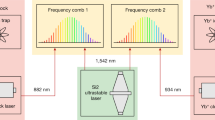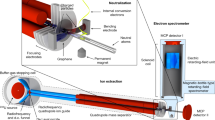Abstract
THE second of time is now defined in terms of the hyperfine line of caesium-133, and is that interval which makes the frequency of the spectral line 9192631770 Hz (ref. 1). The second model of the National Physical Laboratory (NPL) standard described briefly in 1959 (ref. 2) has operated since then at a value estimated to be within one part in 1011 of the spectral line frequency, or approximately 1 µs per day. It can be used with a precision ten times better than this, and the main limitation to the use of the full precision is the possibility of a frequency shift due to a small phase difference between the two ends of the cavity resonant structure. The symmetry of the resonance shows that an error due to this cause does not exceed one part in 1011. Another way of checking the phase error is to reverse the cavity physically, thus reversing the effect. This method was used with the first NPL standard3 and also at the National Bureau of Standards (NBS)4, the National Research Council of Canada5 and the Laboratoire Suisse de Recherches Horlogères6. Its drawbacks are that it involves the physical handling, movement and refixing of the cavity structure, and it occupies a time of possibly several days, during which the comparison standard must remain constant. The NBS overcame the handling problem by reversing the positions of the oven and detector, but although they then obtained more consistent results they were left with a residual uncertainty of ±3 parts in 1012. The residual uncertainty at the Laboratoire Suisse de Recherches Horlogères was ±5 parts in 1012, although at the National Research Council, Ottawa, a frequency difference of 5 parts in 1012 due to this effect was reproduced in two measurements to 4 parts in 1013, a hydrogen maser being used as the comparison standard.
This is a preview of subscription content, access via your institution
Access options
Subscribe to this journal
Receive 51 print issues and online access
$199.00 per year
only $3.90 per issue
Buy this article
- Purchase on Springer Link
- Instant access to full article PDF
Prices may be subject to local taxes which are calculated during checkout
Similar content being viewed by others
References
Bureau International des Poids et Mesures, CR, 11e Conférence Générale des Poids et Mesures, Paris 1967–68,103 (1969).
Essen, L., and Parry, J. V. L., Nature, 184, 1791 (1959).
Essen, L., and Parry, J. V. L., Phil. Trans. Roy. Soc., A, 250, 45 (1957).
Beehler, R. E., and Glaze, D. J., IEEE Trans. Instrum. and Meas., IM 15, 48 (1966).
Mungall, A. G., Bailey, R., Daams, H., and Morris, D., Metrologia, 4, 165 (1968).
Kartaschoff, P., publication of the Laboratoire Suisse de Recherches Horlogères, Neuchatel, 1963.
Author information
Authors and Affiliations
Rights and permissions
About this article
Cite this article
ESSEN, L., SUTCLIFFE, D. Improvement to the National Physical Laboratory Atomic Clock. Nature 223, 602–603 (1969). https://doi.org/10.1038/223602a0
Received:
Issue Date:
DOI: https://doi.org/10.1038/223602a0
Comments
By submitting a comment you agree to abide by our Terms and Community Guidelines. If you find something abusive or that does not comply with our terms or guidelines please flag it as inappropriate.



